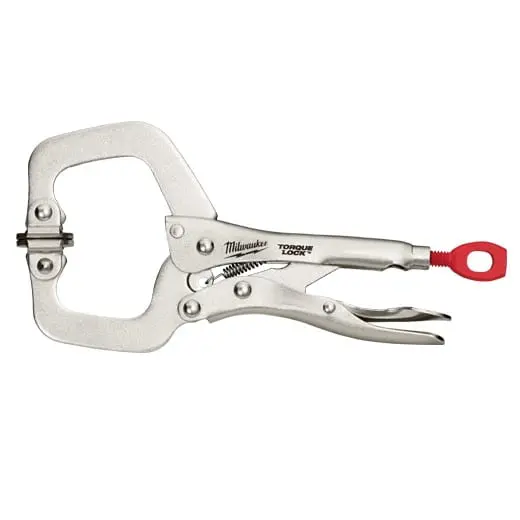Milwaukee recently released their new Milwaukee TORQUE LOCK locking pliers and C-clamps with Durable Grip and asked if I would be up for trying them out. Initially, what appealed to me most were the locking C-clamps. Of all the clamps in my shop, my “go-to” is the IRWIN locking C-clamp. I have roughly ten of them and they all get used consistently. They’re easy to set up—the one-handed operation leaves your other hand free to hold the workpiece—and you get an insane amount of clamping force for the effort.
I use these pliers and clamps for woodworking and steel working about equally. I hadn’t really felt like there was much worthy competition for the IRWIN clamps until I saw the new TORQUE LOCK system. It looked to be a pretty impressive enhancement and the tool was actually made by a quality brand, so I was happy to put them through the wringer.
Milwaukee TORQUE LOCK Out of the Box
The Milwaukee Durable Grip Pliers come in an array of sizes, so I tried to get a nice sampling with the 7” and 10” set and the 9” Long Nose. One of the first things I noticed is that there is no release lever like there is on my IRWIN Vise-Grip Locking Pliers. It’s a lever-less release mechanism. The large grips were very well-sized and definitely felt more comfortable and sturdy in my hand. Construction and weight seemed on par with the IRWIN Vise-Grips, which I’d considered to be the standard here, but with added (and innovative) Milwaukee TORQUE LOCK adjustment.
Milwaukee Torque Lock vs Irwin Vise Grips and Clamps
The Milwaukee locking C-clamps selection is a bit narrower. There are just two sizes: a 6” and an 11”. I’ll have one of each, please! While it’s true I only use two sizes of IRWIN clamps, they’re the 11” and the bigger 18”. Examining the 11” Milwaukee clamp right next to my 11” IRWIN, they are surprisingly similar. One is a little thinner here, the other a little thinner there, but nothing significant stood out to me aside from the new Milwaukee TORQUE LOCK adjustment. Again, I’d considered IRWIN the standard in locking C-clamps, so this initial comparison bodes well for Milwaukee.

Milwaukee Locking C-Clamps
After a few weeks of adding the Milwaukee TORQUE LOCK locking C-clamps to the mix, I found a couple of unexpected bonuses. First is how much more comfortable the release lever is on the backs of your fingers. The lever is much flatter than the IRWIN and this made a significant difference when I was grinding steel and constantly releasing/moving the clamps around with one hand. The second unexpected bonus feature is the ability to use the TORQUE LOCK system in reverse. When clamped really tight, locking C-clamps can be difficult to release.
Prying against the release lever with a screwdriver does the trick, but they’ll pop free suddenly, frequently causing the spring to dislodge. But the TORQUE LOCK system actually allows you to back off the tension slowly without causing any sudden jolt.

Clamping Force Compared
Now, on to the expected: clamping force. I set up a simple comparison where I clamped a piece of steel to bend against the Milwaukee and another against the IRWIN. First I clamped both as tight as humanly possible and then I applied bending force to the steel and got about equal movement from both clamps. Now it was time to torque down on the Milwaukee. I stuck a hefty screwdriver in the TORQUE LOCK and got about ½ turn more, then went back to check the difference: much less movement. So, does the Milwaukee TORQUE LOCK work? Absolutely. Was I nervous I was going to break it? Yeah, kinda. Did it actually break? NO!


The 6” locking C-clamp has been steadily working its way into use. I’ve been so used to reaching for the 11” locking c-clamps for everything that I had to make a conscious effort to remember to “use the 6” clamp.” And the more I used it, the more I found its size convenient. There’s no doubt the 11” clamp handle can get in the way when you’re working in a tight area and the 6” clamp eliminates this problem in many situations. I found I was able to stick with a locking C-clamp in a few spots where I would have had to switch to a bar clamp, primarily at the drill press and metal-cutting bandsaw. So the little guy is definitely becoming a fixture in a few shop areas.
Ergonomics
The Durable Grip Pliers were hands down more comfortable than what I was using before. I felt like I could get more clamping force because of the large grips, but I had no definitive way to measure that and it could have just been that it was less fatigue on my hands to close them. Either way, I’ll take it. The lever-less release is a great design and with the comfortable grips, these were even easier on the backs of your fingers to release than the Milwaukee locking C-clamps.

I did find the Milwaukee TORQUE LOCK system had a tendency to twist the pliers when gripping smaller items like a stuck drill bit, but even that extra ¼ turn will give you more bite than what you could get without it. These are now the most comfortable pliers that I have, and lucky me, they have the tightest grip. The dust will soon be forming on my other pliers and Vise-Grips.






